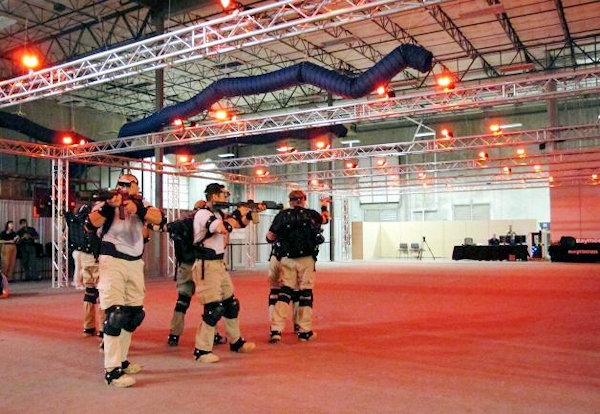[From The Plano Star-Courier, where the story includes more images]
Bridging the gap between reality and the virtual world
By Bill Conrad
Published: Thursday, June 21, 2012
VIRTSIM, the next innovation in tactical police and military training, was unveiled Friday morning in an east Plano warehouse owned by Raytheon. To date, the technology has been sold to the FBI, and has also been used by U.S. armed forces, U.S. Marshals and police departments in cities such as Plano and Frisco.
Eight members of the McKinney Police Department’s S.W.A.T. team donned special goggles, firearms and motion-capture equipment prior to beginning their training exercise on VIRTSIM. The program, developed by Georgia-based Motion Reality, allows officers and soldiers to experience realistic training scenarios in a safe, easily-controllable environment.
Officers trained inside a basketball-court size rectangle, which was monitored by cameras that tracked the movement of all participants. The simulation’s controller is able to dial in different scenarios, including mixing “friendly” subjects into a scene filled with criminals. Once a person is wearing the goggles, all connection to the non-virtual world ceases and the person is fully engulfed in the training mission.
“This is a huge help for officers when they are rehearsing a mission,” said Joe Harmon, a retired FBI tactical trainer and Motion Reality employee. “If the department can get the floor plan of a house, we can build a model of the house to the exact specifications using our technology. That is valuable to an assault team because you are not going into the unknown.”
The actual training took place with modified pistols and M4 carbines, and while actual bullets were not used, a modified TENS unit on the officer’s arm released an electric shock when the officer was hit, adding to the scenario’s realism. While the actual training is important, it is the not the primary function of the technology, Harmon said. The most important function, especially for team leaders and mission commanders, is the ability to review the tape from various points of view including first person and overhead.
“When a team trains, the team leader either observes or participates,” Harmon said. “When they participate, it is hard for them to see the movement of every individual. They cannot critique the team members on whether they covered their corner, made an appropriate entry or had good muzzle control. This allows them to see everything they did so they can fully participate and then go back and critique the movement of the team.”
Raytheon’s Peter Ramjug said the company was proud to serve as the exclusive worldwide retailer for the technology. He said the technology is currently for sale or rent to agencies in the United States and around the world. While he would not reveal the technology’s price, Ramjug admitted it was out of the price range of most municipal police departments.
The technology is being demonstrated at Raytheon’s warehouse on Plano Parkway for a limited time, allowing local agencies to train and give feedback to the designers. While the equipment will soon be disassembled, Motion Reality CEO Tom McLaughlin said plans are in place to create permanent facilities across the country in order to make the equipment available to first responders at a fraction of the purchase price.
“For law enforcement one of the things we are looking at exploring — and one of the reasons we are here — is to try and find a way to create regional sites where groups of police who don’t have the budgets to purchase this, could come and pay to train,” McLaughlin. “You really want to make this available to everybody that you can. This is the closest thing to a real-world battlefield.”
While the technology is used for combat training, it could also have additional uses for the military, McLaughlin said.
“We have worked with groups who are helping soldiers dealing with post traumatic stress disorder,” he said, adding the technology has been in development for more than 28 years. “We can put them right back in Afghanistan or Iraq, but now the therapist can become a squad member and help them talk through the situation. You can do anything. It is limited just by your imagination.”
Anyone wishing to see the technology in action doesn’t need to join a police force or enlist in the military. Checking it out is as simple as turning on the TV and popping in a DVD of the highest grossing movie of all time, 2009’s Avatar.
“This [technology] can be used for any virtual world,” McLaughlin said. “Our technology was used in arguably the greatest number of motion pictures in history. We were the technology that made everything move in ‘Avatar,’ all three Lord of the Rings movies, ‘King Kong’ and ‘The Avengers.’ This is putting you into that. I could have a whole bunch of people step into ‘Avatar.'”
A video produced by Raytheon showcasing the technology is available at www.youtube.com/user/raytheoncompany.
